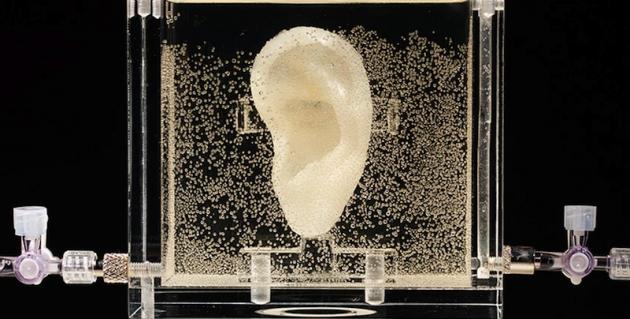A groundbreaking new exhibit of the work titled Sugababe by Diemut Strebe has opened at the ZKM. The work is a replica of Vincent van Gogh’s left ear produced by means of artificially engendered living tissue. The reconstruction not only has the form of van Gogh‘s ear; it is constituted of living cells which contain natural and artificial information derived from one of van Gogh’s envelopes.
The ear’s tissue was produced by means of 3D printers. Visitors can speak to the ear through a microphone. The words change once they pass through the nutrient solution in which the ear is placed and penetrate the artificial nerve tissue. The sound, as perceived by the ear is, in turn, rendered audible through a sound installation. In Sugababe, Diemut Strebe, together with scientists, has regrown Vincent van Gogh’s ear. Vincent van Gogh probably represents more than any other artist the stereotypical romantic image of the artist as a genius.
Even some positions in theory of art tend to a certain mystification of artistic creativity compared to any other form of human innovations. The ear is grown from tissue engineered cartilage and is “identical” in shape to van Gogh’s ear by using computer imaging technology. It is composed of living cells that contain natural genetic information about him as well as engineered components, replicating in the ear as a “living art-piece”. The philosophical Theseus’ paradox forms the literary basis of the scientific approaches used in this art-project, that is the replacement of the genetic code at the molecular level, the cellular organization at the microscopic level and the composition of tissues and organs at the anatomic level. In the late 1st century Plutarch asked in The Life of Theseus whether a ship, which was restored by replacing all its parts, remained the same ship. In the course of time many variations of the principle have been described.
One of these variations refers to the title of the project. The famous paradox is carried out with biological material making a particular form of human replication, from historical or synthesized material, a central focus of this project. The ear is one of a series of a limited edition, made of different scientific components referring in various way to the same principle of replacement. Due to the preservability of the nutrient solution the work Sugababe will only be on display until July 6th, 2014 on the ground floor of the ZKM | Media Museum. Diemut Strebe is represented by the Feldman Gallery, which will present her work in New York in spring 2015. Scientific description Foreign DNA has the ability to replicate in living cells if it is incorporated properly, and if such DNA can be expressed as RNA and its encoded proteins in that species. Replacement of new DNA that is present in living cells with segments of old DNA or synthesized segments of historic DNA can be used to recreate segments of DNA from a historical person that can be incorporated into living cells. By replacement of an entire genome a historical person could in theory be genetically “recreated” by inserting his or her DNA into the cell line of another human. The art-project works with this concept of replacement in various ways. The Custodia foundation in Paris provided an envelope Vincent van Gogh used in 1883.
On the 3rd of September 2012, samples of biological material were taken at Centre Universitaire Romand de Médecine Légale, Lausanne, from the stamp and the flap of an envelope. DNA was extracted, a small part of the mitochondrial DNA was sequenced, cloned in vitro and incorporated into living cartilage cells, which had been acquired from Lieuwe van Gogh, a 4th generation descendant of Vincent van Gogh. As a male descendant in an uninterrupted male line he shares the Y chromosome with Vincent van Gogh and 1/16th of his genome. The mtDNA that was found on the original envelope does not match the van Gogh maternal linage. However, for the principal of replacement it does not matter whether the historical material stems from Vincent van Gogh or anyone else. At this time, only sequenceable historical nuclear DNA, typically derived from bone marrow or teeth, has the ability to replicate and to function within the genome of a living cell line. Consequently, the historical mtDNA from the van Gogh-envelope was used in both a symbolic and to a certain degree conceptual manner. The segments of historic mtDNA were introduced into the nucleus of the cells to grow the ear, attached to entirely synthetic segments of DNA, that produce a foreign fluorescent protein. According to the chronological development of this project in the starting format shown at ZKM | Karlsruhe, the historical mtDNA from the van Gogh-envelope was used and attached to additional DNA, consisting of a vector and a reporter gene, which was then inserted into the nucleus of the cells. It multiplies and replicates as the cell multiplies.
In the course of the project, the described concept of replacement will be developed by using other historical sources of nuclear DNA for the replacement of chromosomes or the replacement of an entire cell nucleus, by using nuclear transfer for cloning, as well as from scratch generated synthetic DNA rather than purely biological samples.
Diemut Strebe, Sugababe, 2014 (ongoing project) © Diemut Strebe.

